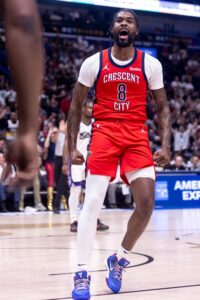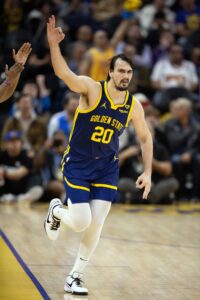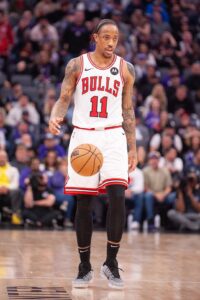The NBA doesn’t technically have a “hard” salary cap in place that teams are prohibited from surpassing during a given league year. But under the league’s current Collective Bargaining Agreement, there are a ton of different ways that a team can impose a hard cap on itself.
We broke down these rules back in December when we updated our glossary entry on the hard cap, but the rules for last season were a little different than the ones that have taken effect this season. And it’s always helpful to have concrete examples to point to in order to illustrate how these rules work.
So we’re taking a deep dive today into how exactly a team can become hard-capped.
There are two levels at which a hard cap can apply: the first tax apron ($178,132,000 in 2024/25) and the second tax apron ($188,931,000). We’ll start with the first apron.
First apron
A team becomes hard-capped at the first tax apron ($178,132,000) by making any of the following moves:
1. Uses the bi-annual exception to sign a player to a contract or to acquire a player via trade or waiver claim.
This one’s not new, and it’s pretty straightforward. Use any portion of the bi-annual exception for any purpose between July 6 and the end of the subsequent regular season and you’re hard-capped at the first apron.
The Rockets (Aaron Holiday) are the only team to use the BAE so far in 2024/25. The Clippers are expected to become the second once they officially sign Nicolas Batum.
2. Uses more than the taxpayer portion of the mid-level exception to sign a player to a contract.
 A team above the first tax apron is permitted to use up to $5,168,000 of the mid-level exception in 2024/25. Use a dollar more than that and the result is a hard cap at the first apron.
A team above the first tax apron is permitted to use up to $5,168,000 of the mid-level exception in 2024/25. Use a dollar more than that and the result is a hard cap at the first apron.
Crucially, this restriction applies not just to dollars but to years as well — a non-taxpayer mid-level signing can be for up to four years, but a taxpayer MLE signing can only cover one or two seasons. So signing a player to a three-year contract using the mid-level would hard-cap a team at the first apron, even if the player’s starting salary is only $3MM.
The Mavericks (Naji Marshall) are the only team to use more than the taxpayer portion of the MLE so far in 2024/25. The Clippers, Warriors, and Bulls figure to join that list once Derrick Jones‘, De’Anthony Melton‘s, and Jalen Smith‘s deals are official.
3. Uses any portion of the mid-level exception to acquire a player via trade or waiver claim.
Beginning in 2024/25, the non-taxpayer mid-level exception, the room exception, and the bi-annual exception can be used to acquire a player via trade or waiver claim. However, the taxpayer mid-level exception cannot.
That means if a team wants the flexibility to operate over the first apron, it can’t use its mid-level exception to trade for a player, even if that player is earning less than the taxpayer portion of the MLE ($5,168,000).
This is why, for instance, the Nuggets – who are operating in first apron territory – couldn’t realistically trade for Russell Westbrook ($4,027,525) using their taxpayer MLE (which would hard-cap them at the first apron), but they’re able to use it to sign a free agent (Dario Saric).
4. Acquires a player via sign-and-trade.
This is another pretty straightforward rule, and one that’s been around for a while. No team can operate above the first apron if they’ve received a player in a sign-and-trade deal.
The Mavericks (Klay Thompson), Warriors (Buddy Hield and Kyle Anderson), Nets (Shake Milton), Hawks (Cody Zeller), and Wizards (Jonas Valanciunas) all fit into this category so far, and the Kings will join them when their sign-and-trade for DeMar DeRozan becomes official.
5. Signs a player who was waived during the regular season and whose pre-waiver salary was higher than the non-taxpayer mid-level exception.
It’s important to note that this rule, designed to regulate the buyout market, only applies if the player is waived after the regular season begins. So after Chris Paul ($30MM salary) was cut on June 30, there were no teams prohibited from signing him. But if Paul had remained on that contract and then been waived during the regular season, only teams operating below the aprons would have been permitted to sign him.
The non-taxpayer mid-level exception this season is $12,822,000, so if a player earning even a single dollar more than that amount is waived during the season, this restriction will apply to whichever team signs him.
6. Uses an outgoing player (or multiple players) in a trade for matching purposes to take back more than 100% of the outgoing salary.
It would be simpler to say “take back more salary you send out in a trade and you’re hard-capped at the first apron,” but that’s not quite accurate.
For instance, when a team uses cap room to accommodate extra incoming salary in a trade, no hard cap is created. So the Pistons didn’t hard-cap themselves at the first apron when they traded Quentin Grimes ($4,296,682) and took back Tim Hardaway Jr. ($16,193,183) into their cap space. If the Pistons had been operating over the cap and took advantage of the NBA’s salary-matching rules to trade Grimes for a player earning $6MM, that would have hard-capped them at the first apron. But salary-matching wasn’t necessary to take on Hardaway.
Here’s another exception to the rule. Let’s say the Suns trade Nassir Little ($6,750,000) and in return receive one player earning $6.5MM and another player who is in the second year of a two-year, minimum-salary contract (with a cap hit of about $2.4MM). That’s permitted, even though the Suns are a second-apron team taking on more total money in the deal than they’re sending out. Little is earning more than the first player, and his salary isn’t required for matching purposes for the second player, who can be acquired “separately” using the minimum salary exception.
A team is always permitted to use the minimum salary exception to trade for a player whose contract fits into that exception, regardless of the team’s proximity to the aprons.
Essentially, this rule comes down to whether the team is using its outgoing player(s) for the purposes of matching the incoming salary. If so, the incoming salary can’t exceed the outgoing amount by even a single dollar.
The Wizards (Malcolm Brogdon), Thunder (Alex Caruso), Raptors (Sasha Vezenkov), Pelicans (Dejounte Murray), Mavericks (Thompson), and Warriors (Hield/Anderson) are among the teams who have become hard-capped at the first apron in 2024/25 as a result of this rule (if they weren’t already hard-capped for another reason).
This rule also applies to non-simultaneous trade exceptions. A non-apron team that holds a non-simultaneous trade exception is given a $250K allowance above that exception’s amount, but an apron team isn’t permitted to take advantage of that allowance. Doing so would create a hard cap at the first apron.
For example, when the Wizards acquired Valanciunas via sign-and-trade, they used a trade exception worth approximately $9.8MM to give him a starting salary of $9.9MM, taking advantage of that extra $250K in wiggle room. Exceeding the TPE amount hard-capped them at the first apron, though that hard cap would have existed anyway due to the fact that they were taking on Valanciunas via sign-and-trade.
7. Uses a traded player exception generated during the previous offseason or regular season.
A non-simultaneous trade exception can be used anytime for one year after it’s generated, but that time frame becomes significantly condensed for apron teams. Once a team’s season ends and its offseason begins, a team operating above the first apron is not permitted to use a TPE that was created during the preceding regular season or the previous offseason.
For example, the Heat are currently operating above the first tax apron, which means the two trade exceptions they created last July ($9.45MM for Victor Oladipo and $7.24MM for Max Strus) aren’t available to them, and neither is the $6.48MM exception they generated in January by trading Kyle Lowry. Those TPEs are essentially “frozen” and would become available again if Miami moves below the first apron before they expire.
However, an apron team can use a trade exception if it was created since the regular season ended. The Timberwolves, for instance, generated a TPE worth $2.54MM when they traded Wendell Moore to Detroit. That exception is available to them, but the $4MM TPE they created in February for trading Troy Brown isn’t.
As our tracker shows, the Hawks, Nets, Mavericks, Rockets, and Raptors have each used a trade exception this summer that was generated prior to the end of the regular season, so they’re hard-capped at the first apron for 2024/25 (all five teams also made other moves that resulted in that hard cap).
Second apron
A team becomes hard-capped at the second tax apron ($188,931,000) by making any of the following moves:
1. Uses any portion of the mid-level exception to sign a player to a contract.
 The mid-level exception is not available at all to teams operating above the second apron, so a team that uses any portion of it – even an amount well below the taxpayer limit – to sign a player becomes ineligible to surpass the second apron for the rest of the season.
The mid-level exception is not available at all to teams operating above the second apron, so a team that uses any portion of it – even an amount well below the taxpayer limit – to sign a player becomes ineligible to surpass the second apron for the rest of the season.
While no team has officially made a taxpayer mid-level signing yet, the Nuggets are on track to do so with Saric (as noted above), which will hard-cap them at the second apron.
2. Aggregates two or more players in a trade for salary-matching purposes.
“Aggregating” players doesn’t mean simply including them in the same trade — it means combining their salaries for matching purposes in that trade. A team operating above the second apron could make a deal sending out multiple players for one, as long as only one of them is required for salary-matching (and the incoming player is earning less than that outgoing player).
For instance, the Suns could send out Little ($6.75MM) and David Roddy ($2.85MM) for one player earning $6.5MM, since Little’s salary matches for the incoming player, so he and Roddy don’t need to be aggregated together.
When the Kings traded Davion Mitchell ($5.06MM) and Vezenkov ($6.34MM) to Toronto in a deal for Jalen McDaniels ($4.52MM), it didn’t hard-cap Sacramento at the second apron because Mitchell and Vezenkov weren’t aggregated — Mitchell matched McDaniels’ lesser incoming salary on his own.
Let’s say Mitchell’s and McDaniels’ salary figures had been flipped, so McDaniels was the one earning a little more. In that scenario, Sacramento likely would’ve opted to aggregate Mitchell and Vezenkov, even though Mitchell’s salary on his own would have been legally enough to match McDaniels’ incoming figure — not aggregating them and using Mitchell as the sole matching piece would have meant the Kings were taking back more than 100% of his salary, hard-capping them at the first apron.
This is the issue the Knicks ran into in their Mikal Bridges trade with the Nets. Bojan Bogdanovic‘s $19MM+ salary was technically enough to legally match Bridges’ incoming $23.3MM figure, but taking back more than 100% of Bogdanovic’s outgoing money would’ve hard-capped New York at the first apron. The Knicks instead chose to aggregate Milton ($2,875,000) and Mamadi Diakite‘s partial guarantee ($1,392,150) with Bogdanovic’s salary to get to $23.3MM and hard-cap themselves at the second apron instead.
It’s important to note that the team’s position relative to the apron upon the conclusion of the trade (not before the trade) dictates this rule.
Let’s say a team is operating $2MM above the second tax apron and wants to aggregate a $15MM player with a $20MM player for a single player earning $30MM. That would be permitted, since the move would reduce the team’s salary by $5MM, bringing it $3MM below the second apron once the trade is completed. The club would then be prohibited from surpassing the second apron again for the rest of the league year.
The Knicks (for Bridges) and the Pelicans (for Murray) are the only teams so far this season who have aggregated salaries in a trade. But New Orleans is already hard-capped at the first apron, so New York is the lone club hard-capped at the second apron as the result of aggregation.
3. Sends out cash in a trade.
This rule is new, but it’s pretty simple. Send out any amount of cash in a trade and you’re hard-capped for the rest of that league year.
This rule goes into effect as soon as the regular season ends, so a team that sent out cash this June became hard-capped for the rest of 2024/25, even though the league year change didn’t technically occur until July 1. The Hawks, Mavericks, and Thunder each sent out cash in June, which would’ve hard-capped them at the second apron for ’24/25 (all three teams made other moves that ultimately hard-capped them at the first apron instead).
The Pacers and Hornets are the only two teams to this point who are hard-capped at the second apron as a result of sending out cash. Several other teams have traded cash but are hard-capped at the first apron for other reasons.
4. Sends out a player via sign-and-trade and uses that player’s outgoing salary to take back a contract.
Under the new CBA, there are restrictions facing not just a team that acquires a player via sign-and-trade but to a team that sends out a player via sign-and-trade. That team isn’t allowed to take back salary using the outgoing signed-and-traded player for matching purposes.
For example, the Timberwolves are currently operating over the second apron, so when they signed-and-traded Anderson to Golden State, they would’ve been prohibited from taking back a player in that transaction using Anderson’s $8.78MM salary as a matching piece.
If the Wolves were to acquire an incoming player in that deal using another legal exception (such as the minimum salary exception or the aforementioned Moore TPE), that would have been permitted. But Anderson’s outgoing salary couldn’t be used to match.
The Knicks (Milton) and the Pelicans (Zeller) are the two teams so far this season that used an outgoing signed-and-traded player for matching purposes in a deal. The Bulls will join them as a result of the DeRozan sign-and-trade.
5. Sends out a player via sign-and-trade and uses the resulting traded player exception to acquire a player via trade or waiver claim.
This is basically the other half of the previous rule. Not only could the Timberwolves not take back salary for Anderson in the same deal in which they signed-and-traded him, but they also can’t use the non-simultaneous trade exception generated by his outgoing $8.78MM salary, even though it was newly created this offseason. Using that exception would hard-cap Minnesota at the second apron for the rest of 2024/25.
Besides Minnesota, only the Pelicans (Valanciunas) have created a non-simultaneous trade exception for a signed-and-traded player this offseason. The Bulls will also have one once the DeRozan deal is official.
 The Spurs
The Spurs A team above the first tax apron is permitted to use
A team above the first tax apron is permitted to use  The mid-level exception is not available at all to teams operating above the second apron, so a team that uses any portion of it – even an amount well below the taxpayer limit – to sign a player becomes ineligible to surpass the second apron for the rest of the season.
The mid-level exception is not available at all to teams operating above the second apron, so a team that uses any portion of it – even an amount well below the taxpayer limit – to sign a player becomes ineligible to surpass the second apron for the rest of the season.